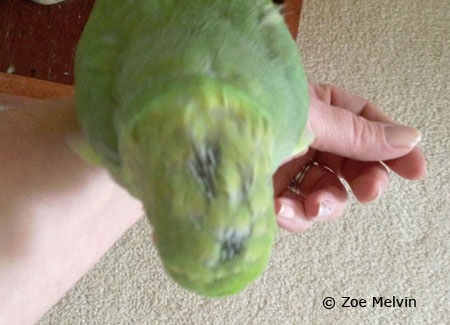Bird hELP CENTER
bird Question:
Molting Female Indian Ringneck
Could you please let me know if this is to be expected when molting
or if there is something more serious going on. My IRN is female and 2
1/2 years old. Her body is fine, just her head mainly.
I took her to the vet & they said she may have a kidney problem as runny
poo now & again. They did not test her poo but she is on antibiotics.
They recommended feeding her Harrisons pellets. Thank You.

Answer:
Dear Zoe Melvin,
First, let me put you at ease and tell you that your Ringneck does not
seem to have a problem in the photo you submitted. In fact, it seems to
be just a simple yearly molt. You had stated in your question that your
female Ringneck was 2 1/2 years old and this would be about the time a
heavy molt sets in.
When Ringnecks are younger their feathers tend to be softer and will
remain with the bird for roughly 18 months until the onset of its first
heavy molt. This heavy molt usually begins right after an Indian
Ringnecks breeding season in the hotter months of summer. This gives the
bird the opportunity to shed some feathers without putting itself in
real danger due to the loss of heat.
Even more important, is this yearly shedding of the old and damaged
feathers and the regrowth of new feathers keeps the bird in optimal
condition for flight. You might find that your female becomes a tad bit
nippy during this stage and that's quite okay.
In this particular photo your female has pin feathers. These are
basically immature feathers inside the straw like structures that are
protected until the feather matures. You can look at this process a lot
like a caterpillar in a cocoon. Once the larva matures out emerges a
beautiful butterfly. It's a very similar concept with your pet parrot.
During the molting process you might try to substitute more
protein-based foods for your Ringneck. The molting process uses a lot of
nutrients the bird has stored. You should provide more protein items
such as lentils, beans, and small portions of meat. Try to stay away
from too much meat as parrots are naturally herbivores. An occasional
chunk of meat once a week will do no harm. But protein from plant-based
items is mostly preferred.
It's wonderful that you took your female Ringneck to the vet and you did
the right thing. Obviously, he was not too concerned about her health as
he did not run lab tests. Most avian veterinarians who suspect some type
of ailment will quickly do some lab work to see if any terminal
illnesses are present. As far as kidney problems I would not worry too
much as even my Ringnecks sometimes produce watery stools. Should you be
concerned, it is always best to have your veterinarian run some tests to
be sure she is in optimal condition. He did prescribe her antibiotics
and if a bacterial infection is present, that should take care of the
problem.
I hope this response helps put you at ease. The molting process roughly
takes about a month sometimes a week longer to complete. In no time your
female Ringneck will be looking sleek and smooth and this time around
she will have a longer tail.
Best wishes! IMRAN-C




